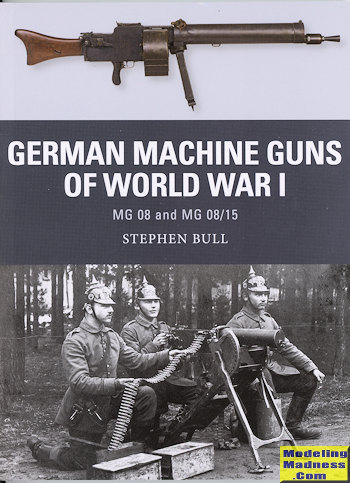 World War
One saw the use of several types of weapons that would become staples in warfare
in the years after. The airplane, the tank, and probably most widely used, the
machine gun. Machine guns were not brand new, having been used by the British
during the Boer war and several other smaller conflicts of the late 1800s and
early 1900s. But it was WWI that saw it domanate the battle field. The book
states that between 60-90% of all the small calibre rounds expended in 1916 came
from machine guns.
World War
One saw the use of several types of weapons that would become staples in warfare
in the years after. The airplane, the tank, and probably most widely used, the
machine gun. Machine guns were not brand new, having been used by the British
during the Boer war and several other smaller conflicts of the late 1800s and
early 1900s. But it was WWI that saw it domanate the battle field. The book
states that between 60-90% of all the small calibre rounds expended in 1916 came
from machine guns.
The Germans were a major user of the guns, and once they figured out the best
way to utilize them, the results were truly devastating to the troops of the
Entente. It was realized that a single machine gun could hold back a battalion
of troops and when strategically placed, they effectively stopped any advance,
part of what made WWI in the West such a stalemate.
However, machine guns of the time had their issues. One
is that they were expensive to manufacture. Another is that they were heavy.
They also require cooling water around the barrel to prevent it from distorting
due to the heat of firing and these barrels were not easy to change. They also
required a team of men to operate. However, thanks to the weight of the gun and
its mount, they were deadly accurate and able to produce a withering fire into
specific spots. They were also able to destroy any soft skin vehicles and even
the new tanks. It is telling that after the end of the war, the much reduced
German Army was severely limited to the number of machine guns it was able to
field.
While the British and Americans also had machine guns,
this book concentrates on those operated by Germany. Not surprisingly, most of
the guns used during the war were Maxim designs with the Maxim MG08 being the
main gun that was even used throughout WWII. This gun was modified over time and
eventually resulted in the lighter MG08/15 which was barely able to be operated
by a single person, much like an assault rifle of today. Germany never really
did develop a light, air cooled gun like the British Lewis or the US B.A.R.,
though the Parabellum was used on aircraft and was air cooled. However, the
Parabellum needed airflow and it wouldn't get that on the ground.
The author follows the standard format of this series,
starting with the development of the gun and other types that were developed,
but not widely used, such as the MG 16. A substantial part of the book covers
the use of these guns during battle and how their use changed with time. Post
war use of the guns is also included. A fairly good size section provides
insight into how the use of this gun affected both sides in the war. Its impact
can be seen in the development of static, trench warfare. If one cannot move a
mass of men without worrying about them being killed by machine guns, then one
doesn't move very far. I should point out that while the machine gun caused a
large number of casualties, it was artillery that generally killed more. In all,
it is a superb book that offers not only a history of these weapons, but also
how they changed warfare.
May 2016
Copyright ModelingMadness.com
For more on the complete line of Osprey books,
visit www.ospreypublishing.com
If you would like your product reviewed fairly and quickly, please
contact
me or see other details in the Note to
Contributors.
 World War
One saw the use of several types of weapons that would become staples in warfare
in the years after. The airplane, the tank, and probably most widely used, the
machine gun. Machine guns were not brand new, having been used by the British
during the Boer war and several other smaller conflicts of the late 1800s and
early 1900s. But it was WWI that saw it domanate the battle field. The book
states that between 60-90% of all the small calibre rounds expended in 1916 came
from machine guns.
World War
One saw the use of several types of weapons that would become staples in warfare
in the years after. The airplane, the tank, and probably most widely used, the
machine gun. Machine guns were not brand new, having been used by the British
during the Boer war and several other smaller conflicts of the late 1800s and
early 1900s. But it was WWI that saw it domanate the battle field. The book
states that between 60-90% of all the small calibre rounds expended in 1916 came
from machine guns.